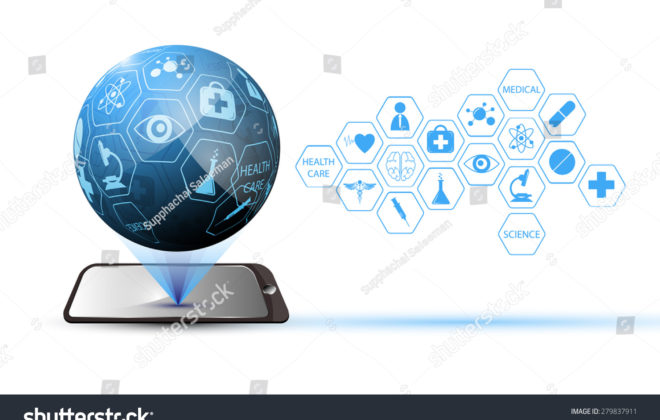What is Augmented Intelligence in Healthcare?
As electronic health records have become acceptable and accessible, there is so much in the healthcare space that can transform with machine intelligence. Machine learning and artificial intelligence technologies are now being used by healthcare institutions to improve diagnosis and care.
But, to facilitate the technology’s widespread use and implementation, it will have to pass the litmus test of compliances and standards. While that looks less likely to happen with AI implementation anytime soon, another relevant field is gaining traction in the healthcare space.
Augmented intelligence – a concept that reflects the enhanced capabilities of human decision-making in clinical settings when augmented with computation systems and methods. While artificial intelligence promises to replicate all of the human’s intelligence, augmented intelligence claims to enhance and scale it.
Augmented intelligence can increase the efficiency and speed of diagnosis in healthcare organizations. Let’s explore how.
How Augmented Intelligence Supports Clinical Decision-Making
Augmented intelligence makes more sense than artificial intelligence, especially in healthcare. This is because it highlights the enhanced capabilities of a human when augmented with the right tools and technologies- something that can be seen as a potential reality soon.
In a sensitive industry such as healthcare, human intelligence cannot be replaced. Augmented intelligence specifies systems that augment human intelligence rather than attempt to replace them.
Combining AI systems with an irreplaceable human clinician can advance care delivery in ways that outperform what either of them can do alone. According to the American Medical Association, healthcare AI offers a transformative set of tools to help physicians, patients, and countries to deal with cost challenges, quality struggles, and more.
In a recent interview, a dermatologist highlighted how augmented intelligence could improve clinical decision making. Non-dermatologists rarely have the same visual knowledge as practicing dermatologists, he said. This implies that the former is less capable of describing a rash condition as well as a dermatologist. Therefore, they implemented a solution with machine learning to augment the ability of general practitioners to describe symptoms of rash and identify diagnostic probabilities. While machine learning methods will still get better, this can be seen as a starting point for the application of augmented intelligence in healthcare.
Let’s expand on this with a few more possible and current use cases of AI in healthcare.
The Various Use Cases of Augmented Intelligence in Healthcare
Let’s look at a few real-world use cases of augmented intelligence. These go to show how large healthcare organizations are using the technology to drive transformation and bring better clinical outcomes.
- Care coordination command center – Tampa General plans to launch a command center that processes real-time streams of data from various sources. This command center will offer suggestions and alerts to help hospitals track the progress of their patients, prevent and predict risks, and manage staff workload.
- AI-based app for mental health tracking – Ginger.io is one of the tools using big data and analytics to provide behavioral health support (mindfulness training and cognitive behavioral therapy) to patients by therapists, coaches, and psychiatrists. The app uses augmented intelligence to track how consumers use their smartphones to spot patterns and create tailored mental health programs.
- Population health management – NextHealth’s predictive analytics platform is leveraged by organizations for population health management by identifying opportunities for risk-reduction. Through the platform, healthcare institutions can identify high-risk populations and develop personalized treatment plans and recommendations for them to reduce costs and improve outcomes.
Reasonably, the best deployments of artificial intelligence in healthcare are in the form of augmented intelligence. Here, doctors and nurses can perform at their best by being offered timely, data-driven treatment recommendations that they can accept, modify, or reject, based on their personal expertise and experience and judgment of the situation context at any given time.
Why augmented intelligence is a better deal in healthcare than artificial intelligence
Can we possibly trust machines with our lives? Not yet. And probably not anytime soon. Therefore, we are not yet looking at completely replacing doctors and healthcare staff. What we need is to find synergies between machines and physicians so that machines can assist the former in doing what they do – faster and more efficiently.
When machine intelligence assists human intelligence, it can eliminate human errors and fill in gaps that are hard for another human to plug. This collaboration between machines and humans is what’s desirable at the moment in terms of augmented intelligence.
When tech and touch work in collaboration, the combination can deliver the best outcomes for both the physician and the patient. Real, raw, artificial intelligence seems to be non-existent for several years to come when we talk about clinical care.
Balancing data privacy and information sharing for secure augmented intelligence
Data is the foundation on which any technological advancement is built. As such, data privacy and sharing have been two massive concerns for the healthcare industry in adopting the latest technologies. Being transparent with consumers and obtaining informed consent from them can be the first step in ensuring that customers know their data is stored and used for research and analysis.
If organizations explicitly tell patients how they plan on using their data to improve care, they will be eager to participate. Healthcare organizations must engage patients in a dialog instead of keeping them in the dark about their data.
Mobile apps, such as those that allow patients to upload their medical data directly from hospital servers, can prove to be useful. The technology company does not stand in the middle of the transaction, and the healthcare information does not go through their servers. This way, patients can determine who they give access to their medical data.
Examples such as this are promising. But it takes integrity and commitment to data privacy to makes things like this work. Businesses need to ensure patients’ expectations of data privacy are met if augmented intelligence has to be implemented at scale.
Smart hospitals around the world are already exploring the many possibilities of Augmented Healthcare. Are you?




